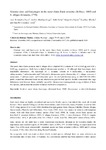Genome sizes and karyotypes in the razor clams "Ensis arcuatus" (Jeffreys, 1865) and "E. siliqua" (Linnaeus, 1758)

Use este enlace para citar
http://hdl.handle.net/2183/21432Colecciones
- Investigación (FCIE) [1150]
Metadatos
Mostrar el registro completo del ítemTítulo
Genome sizes and karyotypes in the razor clams "Ensis arcuatus" (Jeffreys, 1865) and "E. siliqua" (Linnaeus, 1758)Autor(es)
Fecha
2008-03Cita bibliográfica
Genome sizes and karyotypes in the razor clams Ensis arcuatus (Jeffreys, 1865) and E. siliqua (Linnaeus, 1758). J. Fernández-Tajes, A. Martínez-Lage, R. Freire, A. Guerra, J. Méndez and A. M. González-Tizón, Cah. Biol. Mar. 2008, 49(1): 79-85.
Resumen
[Abstract] The razor clams Ensis arcuatus and E. siliqua show a diploid DNA content of 3.85 ± 0.049 pg and 4.00 ± 0.050 pg, respectively. Both have a diploid chromosome number of 38 although their karyotypes show remarkable differences. The karyotype of E. arcuatus consists of 4 metacentric, 1 metacentric-submetacentric, 7 submetacentric and 7 telocentric chromosome pairs, whereas that of E. siliqua possesses 3 metacentric, 7 submetacentric and 9 telocentric pairs. In situ hybridization using an 18S-5.8S-28S rDNA probe located this ribosomal locus on one chromosome pair for both species. Results demonstrate that large differences exist between them, probably caused by chromosome rearrangements along evolution of these two species, and increase the number of studies on bivalve cytogenetics.
Palabras clave
Bivalves
Razor clam
Karyotype
Ribosomal locus
FISH (Fluorescence in situ hybridization)
Razor clam
Karyotype
Ribosomal locus
FISH (Fluorescence in situ hybridization)
Versión del editor
ISSN
2262-3094
0007-9723
0007-9723





